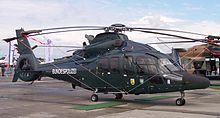Eurocopter EC155
| EC155 | |
|---|---|

| |
| Eurocopter EC155 B1 at Paris Air Show 2007 | |
| Role | Passenger Transport Helicopter |
| Manufacturer | Eurocopter |
| First flight | 17 June 1997 |
| Introduction | March 1999 |
| Developed from | Eurocopter AS365 N3 Dauphin 2 |
| Developed into | Eurocopter X3 |
The Eurocopter EC155 is a long-range medium-lift passenger transport helicopter developed by Eurocopter from the Dauphin family for civil aviation use. It is a twin-engined aircraft and can carry up to 13 passengers along with 1 or 2 crew, depending on customer configuration. The helicopter is marketed for passenger transport, offshore support, VIP corporate transport and casualty transport duties.
Development
Originally designated AS365 N4, the EC155 was developed from the Eurocopter AS365 N3 Dauphin 2 with the aim of significantly increasing the cabin space of the Dauphin. Development began in September 1996 with the helicopter officially announced by Eurocopter at the Paris Air Show in June 1997. The first EC155 helicopter, a modified Dauphin airframe, made its maiden flight at Marignane on 17 June 1997 and the first pre-production EC155 B flew on 11 March 1998. The aircraft received safety certification by the French & German Civil Aviation Authorities on 11 December 1998 and went into production soon after, with a price tag of US$7–8 million depending on installed equipment. Deliveries of the EC155 B began in March 1999, with the German Federal Police becoming the first operator.
The EC155 B1 was developed with more powerful engines and has improved performance at high altitude and in hot temperature conditions. This derivative also features a higher maximum take-off weight (10,846 lb vs. 10,580 lb). Deliveries of this model began in November 2002 with the Hong Kong Government Flying Service becoming the first operator.
Design
The EC155 B features a completely redesigned cabin providing 30% more passenger space than previous Dauphin helicopter models, plus a 130% increase in baggage hold volume. Other major improvements include a five-blade Spheriflex composite main rotor combined with the familiar shrouded Fenestron tail rotor to reduce vibration levels significantly. The EC155 B is powered by two 635 kW (851 shp) Turbomeca Arriel 2C1 turboshaft engines mounted over the luggage hold, which feature a dual-channel Full Authority Digital Engine Control (FADEC) system. The EC155 B1 features uprated 697 kW (935 shp) Arriel 2C2s. The helicopter can be fitted with an anti-icing system to enable the aircraft to operate in very cold climates. The all-glass cockpit is equipped with an 'Avionique Nouvelle' integrated digital flight control system featuring Eurocopter's Vehicle and Engine Management Display (VEMD), which utilizes active matrix liquid crystal displays. The EC155 is also equipped with a four-axis digital autopilot, coupled to the engine FADECs for full-envelope protection, and is offered with a Health and Usage Monitoring System (HUMS).
Eurocopter designed the EC155 originally with three configurations, however, another two configurations were added in 2005. The Passenger Transport version can carry 12 passengers in comfort seats or 13 passengers in utility seats, along with 1 or 2 crew. The VIP or Corporate Transport version has a VIP lounge with working space accommodating up to 8 executives. The Casualty Transport version can carry 2 stretchered patients with up to 4 seated medical staff, or 4 patients on stretchers plus 2 seated medical staff. The configurations added in 2005 were for Offshore operation and Police & Parapublic missions ranging from patrol, airborne surveillance, SAR and EMS, the helicopter being fitted with specific mission equipment for these duties.
Variants
- EC155 - The first prototype, built from modifying an existing Dauphin airframe.
- EC155 B - The first production version, powered by two Turbomeca Arriel 2C1 turboshaft engines.
- EC155 B1 - A more powerful model equipped with two Turbomeca Arriel 2C2 turboshaft engines and higher M.T.O.W., offering enhanced hot/high performance
- AS565 UC - Designation of early military derivative study
Operators


The aircraft is operated by private individuals, companies and charter operators. It is also operated by the government organisations and as an offshore transport for the gas and oil industry.
Specifications (EC155 B1)
Data from {Eurocopter.com}[1]
General characteristics
- Crew: 1 or 2 (pilots)
- Capacity: 13 passengers or 2,301 kg (5,073 lb) payload
- Length: 14.3 m (46 ft 11 in)
- Height: 4.35 m (14 ft 3 in)
- Empty weight: 2,618 kg (5,772 lb)
- Gross weight: 4,950 kg (10,913 lb)
- Max takeoff weight: 4,920 kg (10,847 lb)
- Powerplant: 2 × Turbomeca Arriel 2C2 turboshaft engines, 697 kW (935 hp) each
- Main rotor diameter: 12.6 m (41 ft 4 in)
- Main rotor area: 124.7 m2 (1,342 sq ft)
Performance
- Never exceed speed: 324 km/h (201 mph, 175 kn)
- Range: 857 km (533 mi, 463 nmi)
- Ferry range: 985 km (612 mi, 532 nmi)
- Service ceiling: 4,572 m (15,000 ft)
- Rate of climb: 8.9 m/s (1,750 ft/min)
See also
Related development
- Aérospatiale SA 360 Dauphin
- Eurocopter AS365 Dauphin
- Eurocopter HH-65 Dolphin
- Eurocopter AS565 Panther
- Eurocopter X3
Aircraft of comparable role, configuration, and era
Related lists

